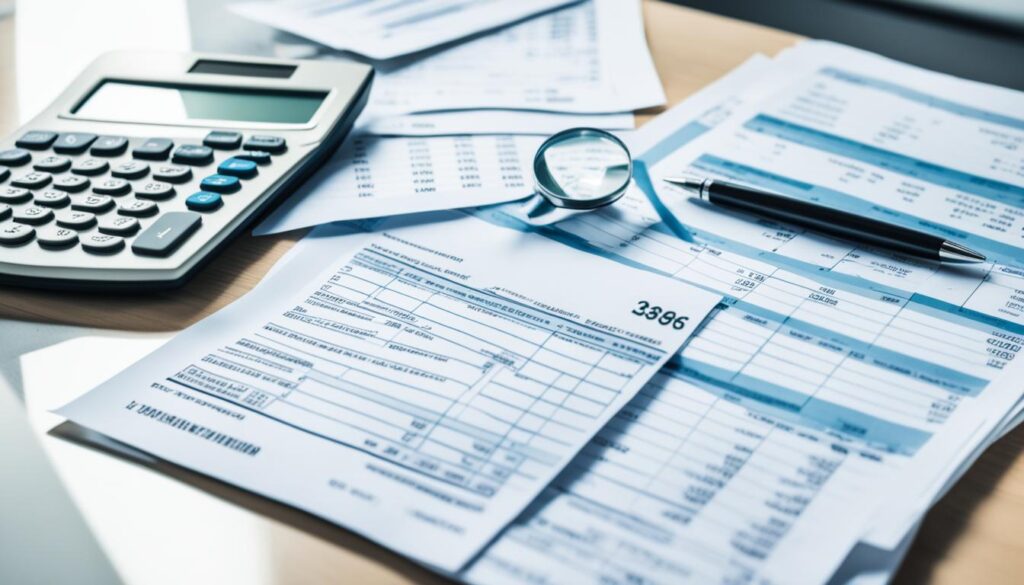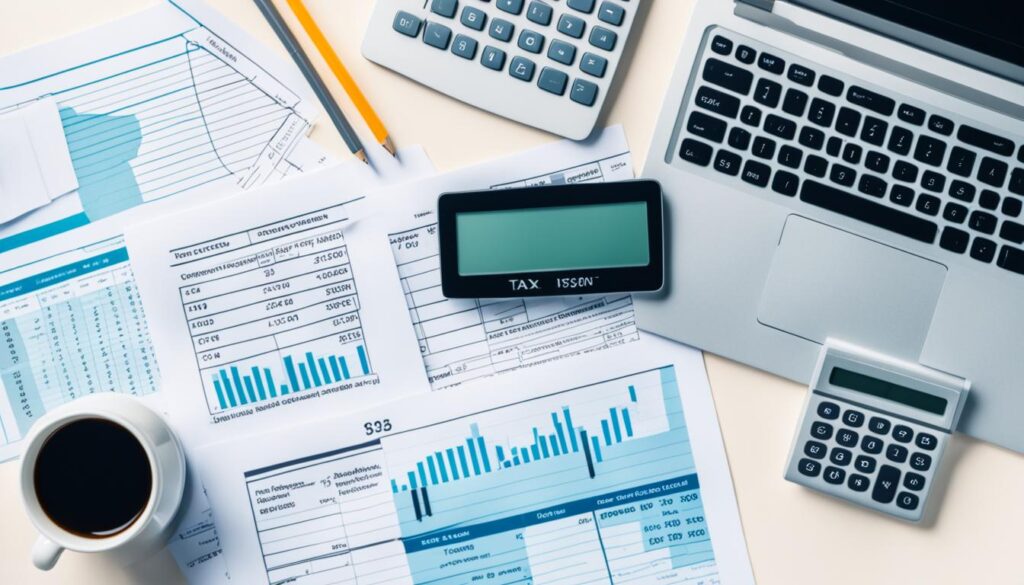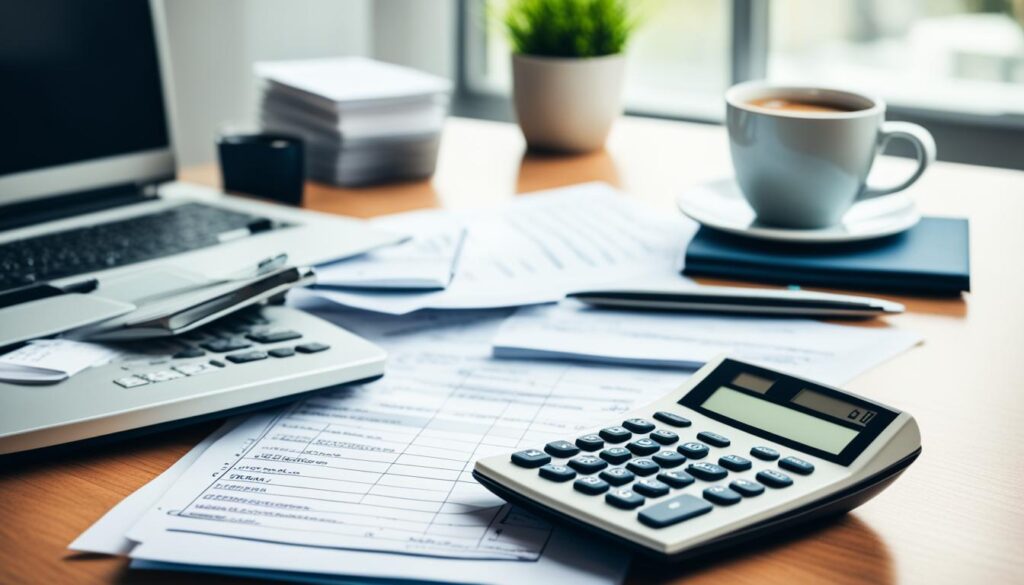Do you know you might be missing out on tax savings? This is through not using the home office tax deduction. It’s useful for both self-employed individuals and those working remotely. Understanding the rules can boost your tax benefits. So, who gets to use this deduction, and how do you figure it out?
This article is your go-to guide on IRS rules for the home office deduction. It will help you check if you’re eligible and explain the best way to calculate your deduction. Let’s get started!

Key Takeaways:
- Qualifying for the home office deduction requires regular and exclusive use of a portion of your home for your business.
- There are specific criteria for the home office deduction, including the “principal place of business” rule.
- Calculating the home office deduction can be done using the standard or simplified method, depending on your circumstances.
- Consulting with a tax professional and keeping detailed records are essential to avoid pitfalls when claiming the home office deduction.
- For more information, refer to IRS Publication 587, “Business Use of Your Home.”
Do I qualify for the home office tax deduction?
To claim the home office tax deduction, you must meet IRS rules. You qualify if you meet one of these criteria:
- Exclusive and regular use: Your home’s portion must only be for business. It shouldn’t be used for anything personal.
- Principal location: Your office should be where your business mainly happens. Or where you often meet clients.
There are special rules for day cares and storage facilities. Also, remote employees can’t claim this deduction.
Make sure your home office fits the requirements to avoid IRS problems. Check IRS guidelines or talk to a tax expert about your eligibility.
“To get the home office tax deduction, your home must be used exclusively for business or be your main business place.”
Exceptions for day care and storage facilities
Though most home offices must meet certain rules, some don’t. Day care and storage facilities are exceptions. You can still qualify if you run these from home without exclusive business use.
If I’m self-employed, should I take the home office tax deduction?
If you’re self-employed, the home office tax deduction is a key way to save money. It lets you write off part of your home expenses as business costs. This can lead to big tax savings.
In the past, people worried this might cause an audit. But now, tax rules have changed to make claiming this deduction easier. If you qualify, there’s no need to miss out on these savings.
You can deduct things like rent, mortgage interest, utilities, insurance, and repairs. These savings can really help self-employed folks.
But, it’s wise to talk to a tax expert to make sure you get it right. They can tell you what you can deduct and how to do it best. This way, you ensure you’re saving as much as you can on taxes.
Benefits of the home office tax deduction for self-employed individuals:
- Maximize tax benefits
- Reduce overall tax liability
- Claim deductions for home expenses
- Consult with a tax professional for expert guidance
Don’t miss this chance to save on taxes. Use the home office tax deduction to lower your tax bill. Do it today.

| Expenses | Amount |
|---|---|
| Rent/Mortgage | $500 |
| Utilities | $200 |
| Insurance | $100 |
| Repairs | $150 |
| Total Deduction | $950 |
What is “exclusive use” and “regular use”?
To get the home office tax deduction, it’s key to understand “exclusive use” and “regular use.” These are crucial for following IRS rules. They help you get home office deductions correctly.
“Exclusive use” involves using part of your home only for work. This area must be only for business, not personal stuff. So, you can’t mix an office and a guest room and still claim a deduction.
“Regular use” means using the space often for your work. Although “regular” isn’t strictly defined, using it for work daily usually qualifies. The IRS looks for consistent business use, not how long you use it.
Understanding “Exclusive Use” for the Home Office Deduction
To deduct your home office, it must be for work only. Keep personal tasks out of this area. Mixing personal internet browsing or bill-paying with business could risk your deduction.
Explaining “Regular Use” for the Home Office Deduction
For IRS approval, your office must also have “regular use” for work. This means consistent business activities there. Whether it’s daily work, client meetings, or other tasks, show regular business use.
By proving “exclusive use” and “regular use,” your office should qualify for deductions. Always keep detailed records and talk to a tax expert to follow IRS rules and get the most benefits.

| Term | Explanation |
|---|---|
| “Exclusive use” | A specific portion of your home is used solely for business purposes and is not used for personal activities. |
| “Regular use” | The designated space is used consistently or habitually for business activities. |
What does “principal place of business” mean?
To qualify for the home office tax deduction, know what “principal place of business” means. Your home office must be the main place for your business or where you see clients regularly.
If you work mainly from home and it’s your business’s heart, you meet this need. Here, most work, like calling clients and planning, happens.
But, if your office is in a separate building, like a garage or studio, rules might differ. Yet, the IRS may let you claim this deduction if you use that space only and often for work.
Meeting with clients or customers:
Your home office also counts if clients come there often. This includes all business gatherings, talks, or presentations at your home.
“My home office is where I meet with my clients to discuss their financial goals and provide investment advice. It’s the central location for my business, and I use it exclusively for business-related activities. As a result, I qualify for the home office tax deduction as my principal place of business.”
To claim the home office tax deduction, you must follow all IRS rules. Keep good records, have proof of your work, and talk to a tax expert to make sure you do everything right.

What qualifies as a business?
To decide if your activities are a business for home office tax deductions, look at the facts and circumstances. The IRS says your business activities must be significant in time, effort, and income. Simply making a profit doesn’t count; you need to meet IRS business requirements.
For instance, property management may qualify for the home office tax deduction. Property managers who handle rentals and related tasks can claim this deduction. But, remember, the rules for property managers differ from those for real estate investors.
“Determining whether your activities meet the criteria of a business for the home office tax deduction can be complex. It’s advisable to consult with a tax professional to ensure you accurately claim the deduction and comply with IRS rules.”
Understanding the IRS Rules for Home Office Deductions
The IRS has guidelines to define a business for home office deductions. These guidelines look at:
- The time you spend on business-related activities: More time and consistency mean a stronger case for being a business.
- The effort you put into your business: A significant effort shows a commitment that matches the deduction’s intent.
- The income generated from your business: There’s no set income level, but reasonable income helps your case.
Remember, deciding if your activities are a business depends on your situation. It’s wise to get advice from a tax professional who knows your circumstances.

Note: The image above is for illustrative purposes only and does not represent an actual home office.
How do I calculate the home office tax deduction?
To understand the home office tax deduction, you need to know the two methods: the standard method and the simplified method.
The Standard Method
First, figure out the portion of your home used for work. This is done by dividing your home office area by the total house area.
Next, you can deduct costs like mortgage or rent, utilities, and repairs. These are based on your office’s portion of the house.
The Simplified Method
The simplified method makes it easier. You take your office area and multiply it by a set rate from the IRS.
If your office is 150 square feet and the rate is $5, your deduction is $750. That’s 150 sq ft times $5.
The limit for the simplified method is 300 square feet. So, the most you can deduct is $1,500, or 300 sq ft times $5.
| Method | Calculation |
|---|---|
| Standard Method | Determine the percentage of your home used for business and deduct a portion of home-related expenses. |
| Simplified Method | Multiply the square footage of your home office by a prescribed rate set by the IRS. |
Both methods come with rules and caps. It’s vital to pick the best one for you. Talking to a tax pro can help ensure you get the most savings.

Which method should I use to calculate my home office deduction?
Choosing the right method for your home office tax deduction is crucial. You have two choices: the simplified method and the standard method. Think about what fits your situation best.
The Simplified Method
The simplified method makes claiming the deduction easy. You deduct $5 for each square foot of your home office, up to 300 square feet. So, the most you can claim is $1,500.
This is great for small home offices. It cuts down on paperwork and helps you save on taxes easily.
The Standard Method
Using the standard method means more detailed paperwork but it’s more flexible. You figure out your deduction based on actual home office expenses.
You’ll need to keep track of costs like mortgage or rent, utilities, insurance, and repairs. These costs are divided by the percentage of your home used for business.
This method can get you a bigger deduction if your home office costs are high. It takes more work, but it can be worth it.
Choosing the Best Method
Your decision hinges on your specific needs. The simplified method is good for ease and small offices. The standard method works well for those with larger expenses and who want precision.
Think about talking to a tax pro. They can help you pick the best method to increase your home office tax breaks.

| Method | Benefits | Considerations |
|---|---|---|
| Simplified Method | Easy to calculate. | Maximum deduction of $1,500. |
| Standard Method | Greater flexibility in deducting actual expenses. | Requires detailed recordkeeping. |
Are there any changes to the home office tax deduction due to COVID-19?
The rules for getting a home office tax deduction haven’t changed, even with COVID-19. More people have been working from home, bringing up questions about extra deductions. But, no specific changes have been made yet. Keep an eye on the IRS for any updates.
With the rise in remote work, many people wondered if the IRS might change the rules. But, the requirements to get a home office deduction stay the same during COVID-19.
To get this deduction, you must use part of your home only and regularly for your business. This place must be where your business mainly happens or where you see clients.
Although no special changes for COVID-19 exist for home office deductions, staying updated with the IRS is key. Things might change, and talking to a tax pro can help you stay informed about any new rules that could impact you.

What are the pitfalls to avoid when claiming the home office tax deduction?
Claiming the home office tax deduction needs careful steps to avoid mistakes. To get the most out of your tax benefits and follow IRS rules for home office deductions, here are key tips:
1. Be accurate and honest
Being exact is crucial when claiming the home office tax deduction. Make sure your home office qualifies. Don’t overdo your expenses or claim things that aren’t true. Doing so could lead to audits or fines.
2. Keep detailed records
For the home office tax deduction, keeping records is key. Keep track of your business activities, costs, and home office information. These records back up your deduction claims and are helpful if the IRS checks.
3. Follow IRS guidelines
Make sure you know the IRS rules for home office deductions. The IRS gives specific rules about who can claim, how to calculate deductions, and which costs are allowed. Following these rules lets you safely claim your home office tax deduction.
Talking to a tax expert is a good idea for the home office tax deduction. They can give you advice, answer questions, and help ensure your deduction is legal.
By being correct, keeping good records, and understanding IRS rules, you can claim the home office tax deduction safely. This helps you get the most from your taxes while staying clear of issues.

Where can I find more information about the home office tax deduction?
For details on the home office tax deduction, check IRS Publication 587. It’s called “Business Use of Your Home (Including Use by Daycare Providers).” It offers clear guidance and examples to make claiming the deduction easier.
If you want to be sure, talk to a tax professional. They can give you advice tailored to your situation. They can also clear up any questions about home office deduction rules.
Using these resources, you’ll understand the home office deduction well. You’ll know how to get the most out of it. And you’ll make sure to follow IRS rules.